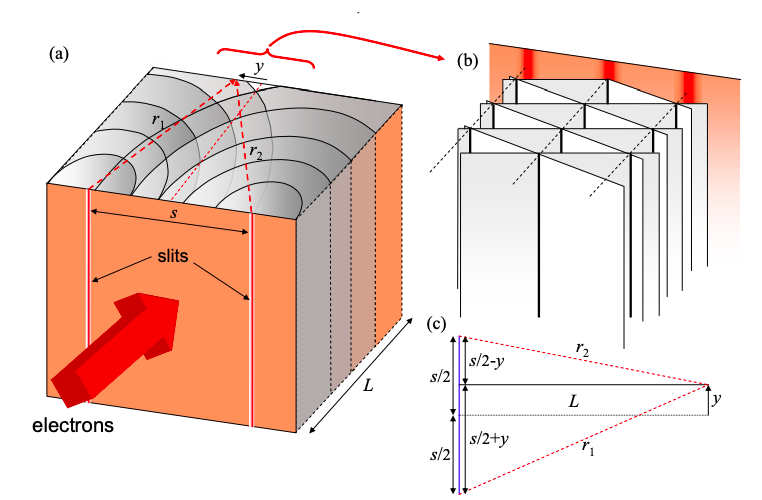1.5: The Double Slit Experiment
- Page ID
- 49368
We now have the tools to model the double slit experiment described above. Far from the double slit, the electrons emanating from each slit look like plane waves; see Figure \(\PageIndex{1}\), where \(s\) is the separation between the slits and \(L\) is the distance to the viewing screen.

At the viewing screen we have
\[ \psi(x=L,t) = A\text{ exp}[i(k_{0}r_{1}-\omega_{0}t)]+A\text{ exp}[i(k_{0}r_{2}-\omega_{0}t)] \nonumber \]
The intensity at the screen is
\[ \begin{align*} |\psi|^{2} &= \{ A \text{ exp}[-i\omega_{0}t](\text{exp}[ik_{0}r_{1}]+(\text{exp}[ik_{0}r_{1}])\}\{A \text{ exp}[-i\omega_{0}t](\text{exp}[ik_{0}r_{1}]+(\text{exp}[ik_{0}r_{1}])^{*} \\[4pt] &= |A|^{2} + |A|^{2}\text{ exp}[i(k_{0}r_{2}-k_{0}r_{1})]+|A|^{2}\text{ exp}[i(k_{0}r_{1}-k_{0}r_{2})]+|A|^{2} \\[4pt] &=2|A|^{2} (1+cos(k(r_{2}-r_{1}))) \end{align*} \nonumber \]
where \(A\) is a constant determined by the intensity of the electron wave. Now from Figure \(\PageIndex{1}\):
\[ r^{2}_{1}= L^{2}+(s/2 -y)^{2} \nonumber \]
\( r^{2}_{1}= L^{2}+(s/2 +y)^{2} \)
Now, if \(y \ll s/2\) we can neglect the \(y^{2}\) term:
\[ r^{2}_{1}= L^{2}+(s/2)^{2}-sy \nonumber \]
\( r^{2}_{1}= L^{2}+(s/2)^{2}+sy \)
Then,
\[ r_{1} \approx \sqrt{L^{2}+(s/2)^{2}}(1-\dfrac{1}{2}\dfrac{sy}{L^{2}+(s/2)^{2}}) \nonumber \]
\( r_{1} \approx \sqrt{L^{2}+(s/2)^{2}}(1+\dfrac{1}{2}\dfrac{sy}{L^{2}+(s/2)^{2}}) \)
Next, if \(L \gg s/2\)
\[ r_{1} \approx L-\dfrac{1}{2}\dfrac{sy}{L} \nonumber \]
\( r_{1} \approx L+\dfrac{1}{2}\dfrac{sy}{L} \)
Thus, \(r_{2}-r_{1} = \dfrac{sy}{L}\), and
\[ |\psi|^{2} = 2|A|^{2} (1+cos(ks\dfrac{y}{L})) \nonumber \]
At the screen, constructive interference between the plane waves from each slit yields a regular array of bright lines, corresponding to a high intensity of electrons. In between each pair of bright lines, is a dark band where the plane waves interfere destructively, i.e. the waves are \(\pi\) radians out of phase with one another.
\[ \dfrac{2\pi}{\lambda}s\dfrac{y}{L}=2\pi \nonumber \]
Rearranging,
\[ y=\dfrac{L\lambda}{s} \nonumber \]


